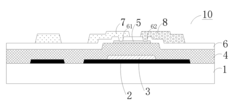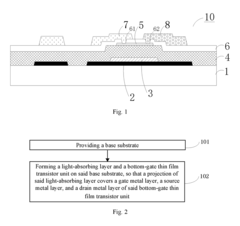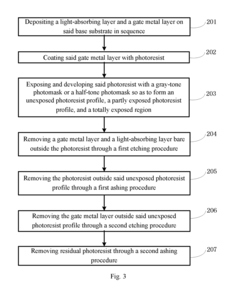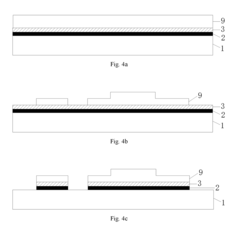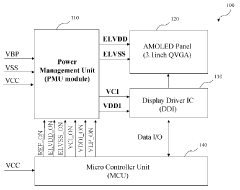Strategies for reducing AMOLED screen-door effects.
JUL 17, 20258 MIN READ
Generate Your Research Report Instantly with AI Agent
Patsnap Eureka helps you evaluate technical feasibility & market potential.
AMOLED SDE Background
AMOLED (Active-Matrix Organic Light-Emitting Diode) technology has revolutionized display screens in recent years, offering superior image quality, vibrant colors, and energy efficiency. However, one persistent challenge that has plagued AMOLED displays is the screen-door effect (SDE), a visual artifact that can detract from the overall viewing experience.
The screen-door effect is characterized by a visible grid-like pattern overlaying the displayed image, resembling the appearance of looking through a fine mesh or screen door. This phenomenon occurs due to the discrete nature of pixel arrangements in digital displays, where individual pixels are separated by small gaps or non-emissive areas.
In AMOLED displays, the screen-door effect is particularly noticeable due to the high contrast ratio and the way organic light-emitting diodes are arranged. The effect becomes more pronounced when viewers are in close proximity to the screen or when the display resolution is insufficient for the viewing distance.
The visibility of SDE can vary depending on factors such as pixel density, subpixel arrangement, and the specific content being displayed. It is often more noticeable in virtual reality (VR) and augmented reality (AR) applications, where users view the display through magnifying lenses, effectively enlarging the pixel structure.
As display technologies have evolved, manufacturers have implemented various strategies to mitigate the screen-door effect. These include increasing pixel density, optimizing subpixel layouts, and employing advanced anti-aliasing techniques. However, completely eliminating SDE while maintaining cost-effectiveness and energy efficiency remains a significant challenge for the industry.
The pursuit of reducing the screen-door effect in AMOLED displays is driven by the growing demand for immersive visual experiences across various applications, including smartphones, televisions, and head-mounted displays for VR and AR. As consumers become more discerning and expectations for display quality continue to rise, addressing SDE has become a critical focus for display manufacturers and researchers alike.
Understanding the background of the screen-door effect in AMOLED displays is crucial for developing effective strategies to mitigate its impact. By examining the underlying causes and the technological context in which SDE occurs, researchers and engineers can explore innovative solutions that push the boundaries of display technology and enhance the overall visual experience for end-users.
The screen-door effect is characterized by a visible grid-like pattern overlaying the displayed image, resembling the appearance of looking through a fine mesh or screen door. This phenomenon occurs due to the discrete nature of pixel arrangements in digital displays, where individual pixels are separated by small gaps or non-emissive areas.
In AMOLED displays, the screen-door effect is particularly noticeable due to the high contrast ratio and the way organic light-emitting diodes are arranged. The effect becomes more pronounced when viewers are in close proximity to the screen or when the display resolution is insufficient for the viewing distance.
The visibility of SDE can vary depending on factors such as pixel density, subpixel arrangement, and the specific content being displayed. It is often more noticeable in virtual reality (VR) and augmented reality (AR) applications, where users view the display through magnifying lenses, effectively enlarging the pixel structure.
As display technologies have evolved, manufacturers have implemented various strategies to mitigate the screen-door effect. These include increasing pixel density, optimizing subpixel layouts, and employing advanced anti-aliasing techniques. However, completely eliminating SDE while maintaining cost-effectiveness and energy efficiency remains a significant challenge for the industry.
The pursuit of reducing the screen-door effect in AMOLED displays is driven by the growing demand for immersive visual experiences across various applications, including smartphones, televisions, and head-mounted displays for VR and AR. As consumers become more discerning and expectations for display quality continue to rise, addressing SDE has become a critical focus for display manufacturers and researchers alike.
Understanding the background of the screen-door effect in AMOLED displays is crucial for developing effective strategies to mitigate its impact. By examining the underlying causes and the technological context in which SDE occurs, researchers and engineers can explore innovative solutions that push the boundaries of display technology and enhance the overall visual experience for end-users.
Market Demand Analysis
The market demand for reducing AMOLED screen-door effects has been steadily increasing in recent years, driven by the growing adoption of AMOLED displays in various consumer electronics. As high-resolution displays become more prevalent in smartphones, tablets, and virtual reality headsets, users are becoming increasingly sensitive to visual artifacts such as the screen-door effect.
The screen-door effect, characterized by visible gaps between pixels, is particularly noticeable in AMOLED displays due to their subpixel structure. This issue has become a significant concern for manufacturers and consumers alike, especially in the rapidly expanding virtual reality and augmented reality markets. The demand for solutions to mitigate this effect is particularly strong in these sectors, as immersive experiences are heavily dependent on visual quality.
In the smartphone market, which continues to be a major driver of AMOLED display adoption, there is a growing emphasis on display quality as a key differentiator among high-end devices. Consumers are increasingly aware of display technologies and their impact on user experience, creating a demand for screens that offer not only high resolution but also smooth, artifact-free visuals.
The automotive industry is another sector showing increased interest in AMOLED displays for infotainment systems and digital dashboards. As these displays become larger and more prominent in vehicle interiors, the need for strategies to reduce screen-door effects becomes more critical to ensure a premium user experience and maintain brand perception.
The professional display market, including monitors for graphic design, video editing, and medical imaging, also demonstrates a strong demand for improved AMOLED display quality. In these applications, the reduction of screen-door effects is crucial for accurate color reproduction and image fidelity.
Market research indicates that consumers are willing to pay a premium for devices with superior display quality, including those with reduced screen-door effects. This willingness to pay has encouraged manufacturers to invest in research and development of new technologies and strategies to address this issue.
The global AMOLED display market is projected to continue its growth trajectory, with an increasing focus on display quality improvements. As competition intensifies, manufacturers are likely to prioritize the development and implementation of strategies to reduce screen-door effects as a means of product differentiation and to meet evolving consumer expectations.
The screen-door effect, characterized by visible gaps between pixels, is particularly noticeable in AMOLED displays due to their subpixel structure. This issue has become a significant concern for manufacturers and consumers alike, especially in the rapidly expanding virtual reality and augmented reality markets. The demand for solutions to mitigate this effect is particularly strong in these sectors, as immersive experiences are heavily dependent on visual quality.
In the smartphone market, which continues to be a major driver of AMOLED display adoption, there is a growing emphasis on display quality as a key differentiator among high-end devices. Consumers are increasingly aware of display technologies and their impact on user experience, creating a demand for screens that offer not only high resolution but also smooth, artifact-free visuals.
The automotive industry is another sector showing increased interest in AMOLED displays for infotainment systems and digital dashboards. As these displays become larger and more prominent in vehicle interiors, the need for strategies to reduce screen-door effects becomes more critical to ensure a premium user experience and maintain brand perception.
The professional display market, including monitors for graphic design, video editing, and medical imaging, also demonstrates a strong demand for improved AMOLED display quality. In these applications, the reduction of screen-door effects is crucial for accurate color reproduction and image fidelity.
Market research indicates that consumers are willing to pay a premium for devices with superior display quality, including those with reduced screen-door effects. This willingness to pay has encouraged manufacturers to invest in research and development of new technologies and strategies to address this issue.
The global AMOLED display market is projected to continue its growth trajectory, with an increasing focus on display quality improvements. As competition intensifies, manufacturers are likely to prioritize the development and implementation of strategies to reduce screen-door effects as a means of product differentiation and to meet evolving consumer expectations.
SDE Challenges
The screen-door effect (SDE) remains a significant challenge in AMOLED display technology, particularly in virtual reality (VR) and augmented reality (AR) applications. This visual artifact manifests as a visible grid-like pattern overlaying the displayed image, reminiscent of looking through a screen door. The primary cause of SDE is the discrete nature of pixel arrangements in AMOLED displays, where the space between individual subpixels becomes noticeable to the viewer.
One of the main challenges in addressing SDE is the inherent trade-off between pixel density and manufacturing costs. While increasing pixel density can effectively reduce SDE, it also leads to higher production expenses and potential yield issues. This balance becomes even more critical in VR headsets, where displays are viewed at close proximity, magnifying the visibility of inter-pixel spaces.
Another significant hurdle is the limitation of current optical systems in VR and AR devices. The lenses used to magnify the display for immersive experiences also amplify the visibility of pixel structures, exacerbating the SDE. Developing advanced optics that can mitigate this effect without compromising image quality or increasing device bulk presents a complex engineering challenge.
Power consumption is an additional concern when tackling SDE. Solutions that involve increasing pixel count or implementing sophisticated pixel arrangements often result in higher energy demands. This is particularly problematic for mobile and standalone VR/AR devices, where battery life is a crucial factor in user experience and device practicality.
The challenge of color accuracy and consistency also comes into play when addressing SDE. Some proposed solutions, such as alternative subpixel layouts or the use of diffusion filters, can potentially impact color reproduction and uniformity across the display. Maintaining high color fidelity while reducing SDE requires careful balancing of various display parameters.
Lastly, the issue of motion artifacts interacts with SDE reduction efforts. As displays strive for higher refresh rates and lower persistence to minimize motion blur, the visibility of pixel structures can become more pronounced during rapid eye or head movements. Developing solutions that effectively reduce SDE without introducing new motion-related artifacts adds another layer of complexity to the challenge.
One of the main challenges in addressing SDE is the inherent trade-off between pixel density and manufacturing costs. While increasing pixel density can effectively reduce SDE, it also leads to higher production expenses and potential yield issues. This balance becomes even more critical in VR headsets, where displays are viewed at close proximity, magnifying the visibility of inter-pixel spaces.
Another significant hurdle is the limitation of current optical systems in VR and AR devices. The lenses used to magnify the display for immersive experiences also amplify the visibility of pixel structures, exacerbating the SDE. Developing advanced optics that can mitigate this effect without compromising image quality or increasing device bulk presents a complex engineering challenge.
Power consumption is an additional concern when tackling SDE. Solutions that involve increasing pixel count or implementing sophisticated pixel arrangements often result in higher energy demands. This is particularly problematic for mobile and standalone VR/AR devices, where battery life is a crucial factor in user experience and device practicality.
The challenge of color accuracy and consistency also comes into play when addressing SDE. Some proposed solutions, such as alternative subpixel layouts or the use of diffusion filters, can potentially impact color reproduction and uniformity across the display. Maintaining high color fidelity while reducing SDE requires careful balancing of various display parameters.
Lastly, the issue of motion artifacts interacts with SDE reduction efforts. As displays strive for higher refresh rates and lower persistence to minimize motion blur, the visibility of pixel structures can become more pronounced during rapid eye or head movements. Developing solutions that effectively reduce SDE without introducing new motion-related artifacts adds another layer of complexity to the challenge.
Current SDE Solutions
01 Pixel arrangement optimization
Improving the pixel arrangement in AMOLED displays can help reduce the screen-door effect. This includes using non-rectangular pixel shapes, varying pixel sizes, or implementing sub-pixel rendering techniques to create a smoother image and minimize visible gaps between pixels.- Pixel arrangement optimization: Improving the pixel arrangement in AMOLED displays can help reduce the screen-door effect. This includes using non-rectangular pixel shapes, varying pixel sizes, or implementing sub-pixel rendering techniques to create a smoother image and minimize visible gaps between pixels.
- Light diffusion techniques: Incorporating light diffusion layers or materials in the display structure can help blur the edges between pixels, reducing the visibility of the screen-door effect. This may involve using specialized films, coatings, or micro-lens arrays to spread light from individual pixels.
- High pixel density displays: Increasing the pixel density of AMOLED displays can significantly reduce the screen-door effect by making individual pixels less distinguishable to the human eye. This approach involves developing manufacturing processes to create smaller, more tightly packed pixels.
- Optical compensation layers: Implementing optical compensation layers or structures between the AMOLED panel and the viewer can help mitigate the screen-door effect. These layers may include specially designed optical films or micro-structures that manipulate light to create a more uniform appearance.
- Active matrix design improvements: Enhancing the design of the active matrix components in AMOLED displays can help reduce the visibility of non-emissive areas between pixels. This may involve optimizing the layout of thin-film transistors, capacitors, and other circuit elements to maximize the light-emitting area of each pixel.
02 Light diffusion techniques
Incorporating light diffusion layers or materials in the display structure can help blur the edges between pixels, reducing the visibility of the screen-door effect. This may involve using specialized films, coatings, or optical elements to spread light more evenly across the display surface.Expand Specific Solutions03 High pixel density displays
Increasing the pixel density of AMOLED displays can significantly reduce the screen-door effect by making individual pixels less distinguishable to the human eye. This approach involves developing manufacturing processes to create smaller, more tightly packed pixels.Expand Specific Solutions04 Micro-lens array integration
Implementing micro-lens arrays on top of the AMOLED display can help focus light from each pixel, reducing the visibility of gaps between pixels and minimizing the screen-door effect. This technique can also improve overall display brightness and efficiency.Expand Specific Solutions05 Active matrix backplane optimization
Improving the design and layout of the active matrix backplane can help reduce the screen-door effect by minimizing the non-emissive areas between pixels. This may involve optimizing transistor layouts, reducing line widths, or implementing new materials and structures to maximize the active display area.Expand Specific Solutions
Key AMOLED Manufacturers
The AMOLED screen-door effect reduction market is in a growth phase, driven by increasing demand for high-quality displays in VR/AR devices and smartphones. The global market size is expanding rapidly, with major players like Samsung Display, BOE Technology, and TCL China Star Optoelectronics leading the charge. These companies are investing heavily in R&D to improve AMOLED technology and reduce screen-door effects. The technology is maturing, with advancements in pixel density, sub-pixel arrangements, and optical solutions. Emerging players like Everdisplay Optronics and Visionox are also contributing to innovation, while tech giants like Meta Platforms and Valve are driving demand through their VR/AR products.
BOE Technology Group Co., Ltd.
Technical Solution: BOE has been working on various strategies to mitigate the screen-door effect in AMOLED displays. They have developed high-resolution AMOLED panels with pixel densities exceeding 800 PPI for VR applications[4]. BOE has also implemented advanced sub-pixel layouts and anti-aliasing algorithms to smooth out pixel edges. Their research includes the use of diffusion films and micro-lens arrays to spread light more evenly across the display surface, effectively blurring the boundaries between pixels[5]. Furthermore, BOE has explored the integration of quantum dot technology with OLED to enhance color performance while reducing visible pixel structure[6].
Strengths: Large-scale production capabilities, diverse range of display technologies. Weaknesses: Slightly behind Samsung in OLED advancements, potential yield issues with cutting-edge technologies.
Samsung Electronics Co., Ltd.
Technical Solution: Samsung has developed advanced AMOLED technologies to reduce screen-door effects. Their approach includes increasing pixel density to over 1000 PPI for VR displays[1], implementing sub-pixel rendering techniques, and utilizing proprietary diamond pixel arrangements. They've also introduced their Quantum Dot OLED technology, which combines OLED with quantum dot color conversion to enhance color accuracy and reduce visible pixel structure[2]. Additionally, Samsung has explored micro-lens array (MLA) technology to improve light distribution and minimize the visibility of individual pixels[3].
Strengths: Industry-leading OLED technology, high pixel density capabilities, innovative pixel arrangements. Weaknesses: Higher production costs, potential for image retention in some scenarios.
Core SDE Reduction Tech
Array substrate, display device, and method for manufacturing array substrate
PatentActiveUS20170148862A1
Innovation
- An array substrate with a light-absorbing layer covering the gate, source, and drain metal layers of a bottom-gate thin film transistor unit, preventing ambient light irradiation while allowing useful light to pass through.
Active-matrix organic light emitting diode display module
PatentInactiveKR1020090117209A
Innovation
- An AMOLED display module comprising a Power Module Unit (PMU), an AMOLED panel, and a Display Driver IC (DDI) is provided, with the PMU generating panel driving and interface voltages using supply power sources in response to control signals, and the DDI driving the panel in response to display data, facilitated by a Micro Controller Unit (MCU).
Visual Comfort Standards
Visual comfort standards play a crucial role in the development and implementation of strategies to reduce AMOLED screen-door effects. These standards are designed to ensure that displays provide a comfortable viewing experience for users, minimizing eye strain and fatigue while maximizing visual clarity and overall user satisfaction.
One of the primary visual comfort standards relevant to AMOLED screen-door effects is the pixel density or pixels per inch (PPI) requirement. Higher PPI values generally result in reduced screen-door effects, as the individual pixels become less discernible to the human eye. Industry standards typically recommend a minimum of 300 PPI for high-resolution displays, with some premium devices pushing beyond 500 PPI.
Another important standard is the contrast ratio, which affects the perceived sharpness and clarity of the display. AMOLED screens are known for their high contrast ratios, often exceeding 100,000:1, which can help mitigate the screen-door effect by creating more defined edges between pixels and subpixels.
Color accuracy and gamut coverage are also essential visual comfort standards. AMOLED displays often aim to meet or exceed the DCI-P3 color space, which covers a wider range of colors than the standard sRGB space. Accurate color reproduction can help mask the screen-door effect by providing a more immersive and natural-looking image.
Brightness standards are equally important, with many AMOLED displays capable of reaching peak brightness levels of 1000 nits or more. Higher brightness can help reduce the visibility of the screen-door effect, especially in well-lit environments or when viewing HDR content.
Flicker-free operation is another critical visual comfort standard. AMOLED displays typically use DC dimming or high-frequency PWM to control brightness, which can help reduce eye strain and fatigue associated with screen flicker. This is particularly important when implementing strategies to reduce screen-door effects, as some techniques may introduce unwanted artifacts or flicker if not properly implemented.
Viewing angle standards are also relevant, as AMOLED displays often maintain color accuracy and contrast at wider viewing angles compared to other display technologies. This characteristic can help maintain the effectiveness of screen-door reduction techniques across different viewing positions.
Finally, motion handling standards, such as response time and refresh rate, contribute to visual comfort. AMOLED displays typically offer fast response times and can support high refresh rates (90Hz, 120Hz, or higher), which can help mask the screen-door effect during motion and provide a smoother overall visual experience.
One of the primary visual comfort standards relevant to AMOLED screen-door effects is the pixel density or pixels per inch (PPI) requirement. Higher PPI values generally result in reduced screen-door effects, as the individual pixels become less discernible to the human eye. Industry standards typically recommend a minimum of 300 PPI for high-resolution displays, with some premium devices pushing beyond 500 PPI.
Another important standard is the contrast ratio, which affects the perceived sharpness and clarity of the display. AMOLED screens are known for their high contrast ratios, often exceeding 100,000:1, which can help mitigate the screen-door effect by creating more defined edges between pixels and subpixels.
Color accuracy and gamut coverage are also essential visual comfort standards. AMOLED displays often aim to meet or exceed the DCI-P3 color space, which covers a wider range of colors than the standard sRGB space. Accurate color reproduction can help mask the screen-door effect by providing a more immersive and natural-looking image.
Brightness standards are equally important, with many AMOLED displays capable of reaching peak brightness levels of 1000 nits or more. Higher brightness can help reduce the visibility of the screen-door effect, especially in well-lit environments or when viewing HDR content.
Flicker-free operation is another critical visual comfort standard. AMOLED displays typically use DC dimming or high-frequency PWM to control brightness, which can help reduce eye strain and fatigue associated with screen flicker. This is particularly important when implementing strategies to reduce screen-door effects, as some techniques may introduce unwanted artifacts or flicker if not properly implemented.
Viewing angle standards are also relevant, as AMOLED displays often maintain color accuracy and contrast at wider viewing angles compared to other display technologies. This characteristic can help maintain the effectiveness of screen-door reduction techniques across different viewing positions.
Finally, motion handling standards, such as response time and refresh rate, contribute to visual comfort. AMOLED displays typically offer fast response times and can support high refresh rates (90Hz, 120Hz, or higher), which can help mask the screen-door effect during motion and provide a smoother overall visual experience.
Energy Efficiency Impact
The energy efficiency impact of strategies for reducing AMOLED screen-door effects is a crucial consideration in display technology development. AMOLED displays are known for their high contrast ratios and vibrant colors, but the screen-door effect can detract from the overall visual experience. Addressing this issue while maintaining or improving energy efficiency is a key challenge for manufacturers and researchers.
One of the primary strategies for reducing the screen-door effect is increasing pixel density. However, this approach can have significant implications for energy consumption. Higher pixel densities typically require more power to drive the increased number of subpixels, potentially leading to greater overall energy consumption. This trade-off between visual quality and energy efficiency necessitates careful optimization of pixel layouts and driving schemes.
Another approach involves the use of advanced subpixel arrangements, such as PenTile or diamond pixel layouts. These designs aim to reduce the visibility of the screen-door effect while maintaining or even improving energy efficiency. By optimizing the arrangement of red, green, and blue subpixels, manufacturers can achieve a better balance between perceived resolution and power consumption.
The implementation of micro-lens arrays is another promising strategy that can contribute to both reduced screen-door effects and improved energy efficiency. These tiny lenses, placed above the OLED pixels, help to focus and direct light more effectively. This can result in improved light output efficiency, potentially allowing for lower driving currents and reduced power consumption while maintaining or enhancing visual quality.
Advancements in OLED materials also play a crucial role in addressing both screen-door effects and energy efficiency. The development of more efficient emissive materials can lead to brighter displays that require less power to operate. This, in turn, allows for the use of smaller subpixels or lower driving currents, which can help mitigate the screen-door effect without sacrificing energy efficiency.
The integration of advanced power management systems is essential when implementing strategies to reduce screen-door effects. These systems can dynamically adjust pixel brightness and power consumption based on displayed content and ambient lighting conditions. By optimizing power usage on a per-pixel or per-region basis, displays can maintain high visual quality while minimizing overall energy consumption.
In conclusion, the impact of screen-door effect reduction strategies on energy efficiency is a complex interplay of various factors. While some approaches may initially seem to increase power consumption, the overall effect on energy efficiency can be mitigated or even improved through careful design and the integration of complementary technologies. As research in this field progresses, we can expect to see further innovations that successfully balance visual quality with energy efficiency in AMOLED displays.
One of the primary strategies for reducing the screen-door effect is increasing pixel density. However, this approach can have significant implications for energy consumption. Higher pixel densities typically require more power to drive the increased number of subpixels, potentially leading to greater overall energy consumption. This trade-off between visual quality and energy efficiency necessitates careful optimization of pixel layouts and driving schemes.
Another approach involves the use of advanced subpixel arrangements, such as PenTile or diamond pixel layouts. These designs aim to reduce the visibility of the screen-door effect while maintaining or even improving energy efficiency. By optimizing the arrangement of red, green, and blue subpixels, manufacturers can achieve a better balance between perceived resolution and power consumption.
The implementation of micro-lens arrays is another promising strategy that can contribute to both reduced screen-door effects and improved energy efficiency. These tiny lenses, placed above the OLED pixels, help to focus and direct light more effectively. This can result in improved light output efficiency, potentially allowing for lower driving currents and reduced power consumption while maintaining or enhancing visual quality.
Advancements in OLED materials also play a crucial role in addressing both screen-door effects and energy efficiency. The development of more efficient emissive materials can lead to brighter displays that require less power to operate. This, in turn, allows for the use of smaller subpixels or lower driving currents, which can help mitigate the screen-door effect without sacrificing energy efficiency.
The integration of advanced power management systems is essential when implementing strategies to reduce screen-door effects. These systems can dynamically adjust pixel brightness and power consumption based on displayed content and ambient lighting conditions. By optimizing power usage on a per-pixel or per-region basis, displays can maintain high visual quality while minimizing overall energy consumption.
In conclusion, the impact of screen-door effect reduction strategies on energy efficiency is a complex interplay of various factors. While some approaches may initially seem to increase power consumption, the overall effect on energy efficiency can be mitigated or even improved through careful design and the integration of complementary technologies. As research in this field progresses, we can expect to see further innovations that successfully balance visual quality with energy efficiency in AMOLED displays.
Unlock deeper insights with Patsnap Eureka Quick Research — get a full tech report to explore trends and direct your research. Try now!
Generate Your Research Report Instantly with AI Agent
Supercharge your innovation with Patsnap Eureka AI Agent Platform!
